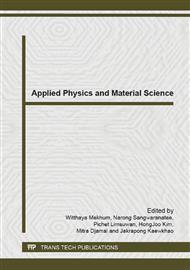[1]
K. Mori, T. Murao, Y. Harada and T. Matsuo, Multi-stage cold deep drawing of long pure titanium cups using coloured sheets for prevention of seizure, CIRP Annals - Manufacturing Technology, 2003, 52(1), 237-240.
DOI: 10.1016/s0007-8506(07)60574-5
Google Scholar
[2]
Ramana PV., Reddy GM., Mohandas T., Gupta AVSSKS., Microstructure and residual stress of similar and dissimilar electron beam welds maraging steel to medium alloy medium carbon steel. Mater Des 2010, 31: 749-760.
DOI: 10.1016/j.matdes.2009.08.007
Google Scholar
[3]
Joost R. Duflou, Amar Kumar Behera, Hans Vanhove, Liciane S. Bertol, Manufacture of accurate titanium cranio-facial implants with high forming angle using single point incremental forming, Key Engineering Materials, Vol. 549, (2013), 223-230.
DOI: 10.4028/www.scientific.net/kem.549.223
Google Scholar
[4]
Zhang Xu-hu, Tang Bin, Zhang Xia-lu, Kou Hong-chao, Li Jin-shan, Zhou Lian, Microstructure and texture of commercially pure titanium in cold deep drawing, Trans. Nonferrous Met. Soc. China 22(2012), 496-502.
DOI: 10.1016/s1003-6326(11)61204-1
Google Scholar
[5]
Kim W. J., Yoo S. J., Jeong H. T., Kim D. M., Choe B. H. and Lee J. B., Effect of the speed ratio on grain refinement and texture development in pure Ti during differential speed rolling, Scripta Materialia, 2011, 64(1): 49-52.
DOI: 10.1016/j.scriptamat.2010.09.002
Google Scholar
[6]
Zhu X. J., Tan M. J. and Zhou W., Enhanced Superplasticity in Commercially Titanium Alloy, Scripta Materialia, 2005, 52(7): 651-655.
DOI: 10.1016/j.scriptamat.2004.11.017
Google Scholar
[7]
Guoquiang Fan, Fengtao Sun, Xiangguo Meng, Lin Gao, Guoquan Tong, Electric hot incremental forming of Ti-6Al-4V titanium sheet, Adv. Manuf. Technol., (2010), 49: 941-947.
DOI: 10.1007/s00170-009-2472-2
Google Scholar
[8]
J. Jeswiet, Asymmetric incremental sheet forming, Advanced Materials Research, (2005), Vols 6-8, 35-58.
Google Scholar
[9]
Li Hua Li, Long Tao, Jin Wang, Cheng Zhao, Application of ISF process for the throttle pedal fixed plate, Applied Mechanics and Materials, (2013), (Volume 372), 450-453.
DOI: 10.4028/www.scientific.net/amm.372.450
Google Scholar
[10]
International Titanium Association (ITA), (2005), p.2, 9.
Google Scholar
[11]
Harry Chandler editor, Heat Treater's Guide: Practices and Procedures for Nonferrous Alloys, Unalloyed Titanium, ASTM Grade 2, UNS R50400, ASM International, (1999), pp.469-470.
Google Scholar
[12]
Ghouse M., Viswanathan M., Ramachandran EG., Electrocodeposition of nickel–molybdenum disulfide and nickel–tungsten disulfide, Met Finish, (1980), 78(4): 44–47.
Google Scholar
[13]
Sunthorn S., Kittiphat R. and Nuttaphong S., The rotational forming tool wear in single point incremental forming process of stainless steel, Tools and technologies for processing ultra highstrength materials, (2011), 421-428.
Google Scholar


